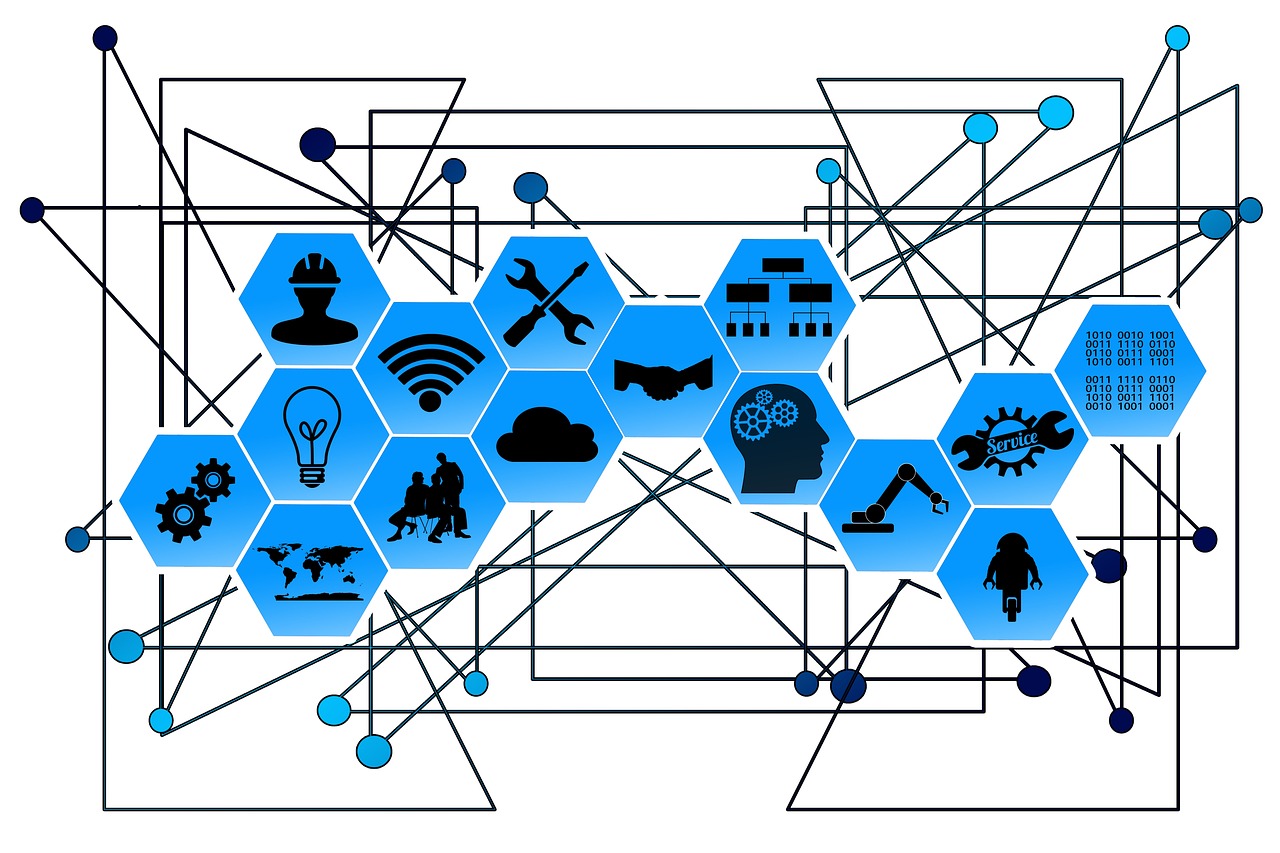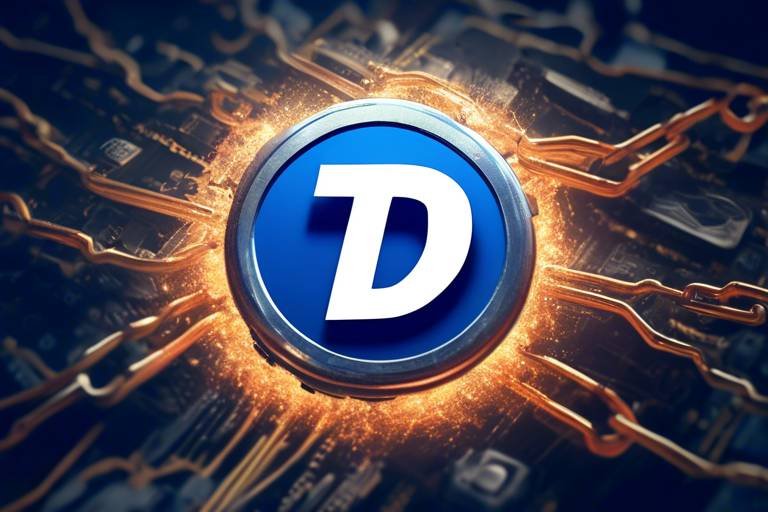Loom Network - Scaling Ethereum with Sidechains
The Loom Network is revolutionizing the way we think about blockchain scalability. As Ethereum continues to grow in popularity, the demand for faster transaction speeds and more efficient processing has never been higher. Imagine trying to get through a crowded subway station during rush hour; it’s chaotic, slow, and frustrating. This is somewhat akin to what happens on the Ethereum network during peak times. Loom Network steps in like a well-organized transit system, offering a streamlined solution that leverages sidechain technology to enhance Ethereum’s capabilities.
At its core, Loom Network is designed to alleviate the congestion that often plagues Ethereum, allowing developers to build decentralized applications (dApps) that can operate seamlessly without the limitations of the main Ethereum chain. By utilizing sidechains, Loom enables transactions to occur off the main Ethereum network while still benefiting from its security and decentralization. This means that developers can create applications that are not only faster but also more scalable, opening the door to innovative solutions in various sectors such as gaming, finance, and social networking.
Think of Loom Network as a bustling city with multiple highways (sidechains) that help distribute traffic (transactions) efficiently, preventing any single road (the Ethereum mainnet) from becoming overly congested. This innovative approach not only enhances the user experience but also significantly reduces transaction fees, making it a win-win for both developers and users. As we delve deeper into the workings of Loom Network, we’ll uncover its unique features, the advantages it offers over traditional Ethereum transactions, and its potential to shape the future of the blockchain ecosystem.
In the following sections, we will explore how Loom Network's sidechain technology works, its key features, real-world applications, and how it stacks up against other scaling solutions like Plasma and Rollups. So buckle up, because the journey into the world of Loom Network is just beginning!

[Understanding Sidechains]
When we dive into the world of blockchain technology, one term that often pops up is sidechains. But what exactly are they? Imagine a bustling city where the main road is constantly congested with traffic. To alleviate this, the city planners decide to build alternate routes that connect to the main road. This is essentially what sidechains do for blockchains like Ethereum. They act as secondary chains that run parallel to the main chain, allowing for transactions and operations to occur without clogging the primary network.
Sidechains enhance the overall scalability of a blockchain by enabling interoperability between different networks. This means that assets can flow seamlessly between the main chain and sidechains, facilitating a more efficient exchange of data and value. By distributing the load of transactions, sidechains can significantly improve transaction speeds and reduce costs, making blockchain technology more accessible and user-friendly.
Moreover, sidechains can be tailored to specific use cases, providing developers with the flexibility to create applications that require unique features or functionalities. For instance, a sidechain designed for gaming might prioritize speed and low fees, while another focused on financial services might emphasize security and compliance. This versatility helps developers innovate without being constrained by the limitations of the main chain.
In addition, sidechains can implement different consensus mechanisms and rules, allowing for experimentation and evolution in blockchain technology. This adaptability is crucial in a rapidly changing digital landscape, where new challenges and opportunities arise every day. For example, a sidechain might utilize a Delegated Proof of Stake (DPoS) system, which can offer faster transaction confirmation times compared to the traditional Proof of Work (PoW) used by Ethereum.
To summarize, sidechains are a vital component of the blockchain ecosystem, providing enhanced scalability, flexibility, and innovation. They allow developers to build decentralized applications that can operate efficiently while maintaining the security and integrity of the main blockchain. As we explore the functionalities and benefits of the Loom Network, it’s essential to understand how sidechains fit into the bigger picture of blockchain technology.

[Loom Network Overview]
The Loom Network is a transformative solution designed to address the scalability issues faced by the Ethereum blockchain. Founded in 2017, Loom Network emerged from the need for a more efficient and user-friendly platform that could support the growing demand for decentralized applications (dApps). Its mission is clear: to provide a robust infrastructure that not only enhances performance but also fosters innovation within the blockchain ecosystem. By utilizing sidechain technology, Loom Network enables developers to build and deploy dApps with greater ease and efficiency, paving the way for a new era of blockchain applications.
One of the standout features of Loom Network is its focus on interoperability. This is crucial in today's blockchain landscape, where various networks and protocols are vying for attention. Loom Network allows for seamless communication and interaction between different blockchain environments, which is a game-changer for developers looking to create versatile and interconnected applications. Imagine being able to transfer assets or data across multiple blockchains effortlessly; that’s the kind of flexibility Loom Network brings to the table.
Moreover, Loom Network is built with developers in mind. It offers a suite of tools and resources that simplify the development process. From Software Development Kits (SDKs) to Application Programming Interfaces (APIs), Loom ensures that developers have everything they need at their fingertips. This accessibility encourages more developers to join the blockchain revolution, ultimately leading to a richer ecosystem of dApps. The platform’s emphasis on user-friendly interfaces also means that even those who are new to blockchain technology can navigate and utilize its features with relative ease.
In addition to its technical prowess, Loom Network is committed to fostering a vibrant community. The team behind Loom actively engages with developers and users alike, providing support and resources to ensure everyone can succeed. This community-driven approach not only enhances the platform's credibility but also creates a sense of belonging among users. As the blockchain space continues to evolve, Loom Network aims to remain at the forefront, pushing boundaries and setting new standards for what is possible in the world of decentralized applications.
In summary, the Loom Network is not just another blockchain solution; it represents a paradigm shift in how we think about scalability and application development. With its innovative use of sidechains, commitment to interoperability, and developer-friendly tools, Loom is well-positioned to play a significant role in the future of the Ethereum ecosystem and beyond. As more developers harness the power of Loom, we can expect to see a surge in innovative dApps that challenge the status quo and redefine our digital experiences.

[Key Features of Loom Network]
The Loom Network stands out in the crowded blockchain landscape due to its unique features that cater specifically to the needs of developers and users alike. One of the most significant aspects of Loom Network is its implementation of the Delegated Proof of Stake (DPoS) consensus mechanism. This innovative approach not only enhances the speed of transactions but also significantly increases the security of the network. By allowing token holders to delegate their voting power to trusted validators, Loom Network ensures that the consensus process is both efficient and democratic, reducing the risk of centralization that can plague other systems.
Another key feature is its user-friendly interfaces. Recognizing that accessibility is paramount for widespread adoption, Loom Network provides intuitive tools that simplify the development process. Developers can easily navigate through the platform, creating decentralized applications (dApps) without getting bogged down by complicated technicalities. This is complemented by the support for various programming languages, which means that developers can use the languages they are already familiar with, making the transition to building on Loom Network seamless.
Moreover, the platform offers a robust set of developer-friendly tools including Software Development Kits (SDKs) and Application Programming Interfaces (APIs). These resources empower developers to build and deploy dApps quickly and efficiently, reducing the time from conception to launch. The availability of these tools fosters a vibrant ecosystem where innovation can flourish, allowing developers to focus on creating engaging user experiences rather than grappling with complex underlying technologies.
In addition to these features, Loom Network also emphasizes scalability. By utilizing sidechains, it can handle a vast number of transactions simultaneously, which is crucial for applications that require real-time interactions like gaming or social networking. This scalability ensures that users experience minimal latency and lower fees, making it an attractive option for both developers and end-users.
To summarize, the key features of Loom Network can be encapsulated as follows:
| Feature | Description |
|---|---|
| DPoS Consensus Mechanism | Enhances efficiency and security through a democratic validator system. |
| User-Friendly Interfaces | Intuitive design that simplifies the development of dApps. |
| Support for Multiple Programming Languages | Allows developers to use familiar languages, easing the transition. |
| Developer Tools | SDKs and APIs that facilitate rapid development and deployment. |
| Scalability | Handles high transaction volumes with minimal fees and latency. |
These features collectively position Loom Network as a formidable player in the blockchain arena, enabling developers to create and scale decentralized applications effectively. The combination of speed, security, and developer support not only enhances the user experience but also sets a new standard for what can be achieved within the Ethereum ecosystem.
- What is Loom Network? Loom Network is a blockchain platform that uses sidechains to enhance scalability and transaction speeds for decentralized applications on Ethereum.
- How does the DPoS mechanism work? The Delegated Proof of Stake mechanism allows token holders to delegate their voting power to validators, ensuring a secure and efficient consensus process.
- What programming languages does Loom Network support? Loom Network supports multiple programming languages, making it accessible for a wide range of developers.
- Can I build games on Loom Network? Yes, Loom Network is particularly well-suited for gaming applications due to its scalability and low transaction fees.
- What advantages does Loom Network offer over traditional Ethereum transactions? Loom Network provides lower fees, faster processing times, and a more user-friendly experience for decentralized applications.

[DPoS Consensus Mechanism]
The Delegated Proof of Stake (DPoS) mechanism is a revolutionary approach to consensus in blockchain technology, and it plays a pivotal role in the functionality of the Loom Network. Unlike traditional Proof of Work (PoW) systems, which rely on miners to validate transactions through computational power, DPoS allows users to vote for a small number of delegates who then handle the transaction validation on behalf of the entire network. This not only enhances the speed of transactions but also significantly reduces energy consumption, making it a more sustainable option for blockchain operations.
Imagine a bustling city where traffic is managed by a few skilled traffic controllers rather than every driver making their own decisions. This analogy illustrates how DPoS streamlines processes, allowing for a more organized and efficient network. In the case of Loom, this means that the platform can handle thousands of transactions per second, a feat that is crucial for supporting decentralized applications (dApps) that require quick interactions. Furthermore, the DPoS system incentivizes delegates to act in the best interest of the network, as their reputation and continued selection depend on their performance.
One of the standout features of the DPoS mechanism is its ability to facilitate community engagement. Users can actively participate in the governance of the network by selecting delegates based on their track record, vision, and proposed improvements. This creates a dynamic ecosystem where the community has a say in how the network evolves, fostering a sense of ownership and responsibility among its participants.
To put the benefits of DPoS into perspective, consider the following table that compares DPoS with other consensus mechanisms:
| Consensus Mechanism | Transaction Speed | Energy Efficiency | Decentralization |
|---|---|---|---|
| DPoS | High | Very High | Moderate |
| Proof of Work | Low | Low | High |
| Proof of Stake | Moderate | High | Moderate |
As seen in the table, DPoS excels in transaction speed and energy efficiency, making it an ideal choice for a network like Loom that aims to support a high volume of dApps and transactions. However, it's important to note that while DPoS offers numerous advantages, it also presents some challenges, particularly concerning decentralization. With a limited number of delegates, there is a risk of centralization if the same individuals or entities are repeatedly elected, which could undermine the democratic nature of the network.
In conclusion, the DPoS consensus mechanism is a cornerstone of the Loom Network, providing a robust solution for scalability and efficiency. By allowing users to vote for delegates, it not only enhances transaction speeds but also encourages community involvement in the governance of the network. As Loom continues to grow and adapt, the effectiveness of its DPoS system will be crucial in maintaining its position as a leading solution in the Ethereum ecosystem.
- What is DPoS? - DPoS stands for Delegated Proof of Stake, a consensus mechanism that allows users to vote for delegates who validate transactions.
- How does DPoS improve transaction speed? - By limiting the number of validators to a small group of elected delegates, DPoS can process transactions much faster than traditional methods.
- Is DPoS environmentally friendly? - Yes, DPoS is more energy-efficient compared to Proof of Work systems, as it requires significantly less computational power.
- Can anyone become a delegate in DPoS? - Yes, any user can become a delegate if they receive enough votes from the community.

[Developer-Friendly Tools]
The Loom Network is not just another blockchain platform; it’s a vibrant ecosystem designed with developers in mind. At the heart of Loom's appeal is its commitment to providing user-friendly tools that simplify the development of decentralized applications (dApps). Imagine trying to build a house without the right tools – it’s nearly impossible, right? Well, Loom ensures that developers have everything they need to construct their digital masterpieces on the Ethereum network.
One of the standout features of Loom Network is its Software Development Kits (SDKs). These SDKs come equipped with pre-built functionalities that allow developers to create dApps without having to reinvent the wheel. For instance, the Loom SDK supports popular programming languages like JavaScript and Go, making it accessible for a wide range of developers. Whether you're a seasoned coder or a newbie, the ease of integration provided by these SDKs can significantly reduce development time and complexity.
Moreover, Loom offers comprehensive Application Programming Interfaces (APIs) that facilitate seamless interactions between your dApps and the Loom blockchain. These APIs are designed to be intuitive, allowing developers to focus more on their application's logic and less on the underlying infrastructure. This approach not only boosts productivity but also encourages innovation, as developers can experiment and iterate on their ideas without getting bogged down by technical hurdles.
Additionally, the Loom Network features a robust documentation hub that serves as a treasure trove of resources. From detailed guides to troubleshooting tips, this hub is an invaluable asset for developers navigating the complexities of blockchain technology. This wealth of information ensures that anyone looking to build on Loom can do so with confidence, knowing that help is just a click away.
To further enhance the development experience, Loom Network hosts a vibrant community of developers who share insights, tips, and best practices. Engaging with this community can be incredibly beneficial, as it fosters collaboration and knowledge-sharing. Developers are encouraged to participate in forums and discussions, which can lead to new ideas and partnerships.
In summary, Loom Network's focus on developer-friendly tools positions it as a leading choice for anyone looking to dive into the world of blockchain development. By providing powerful SDKs, user-friendly APIs, comprehensive documentation, and a supportive community, Loom empowers developers to unleash their creativity and build scalable, efficient dApps that can thrive in today's fast-paced digital landscape.
- What programming languages does Loom Network support? Loom Network primarily supports JavaScript and Go through its SDKs, making it accessible to a wide range of developers.
- How does the documentation help developers? The documentation hub provides detailed guides, troubleshooting tips, and best practices to assist developers in building on the Loom Network.
- Is there a community for developers? Yes, Loom Network has an active community where developers can share insights, ask questions, and collaborate on projects.

[Use Cases of Loom Network]
The Loom Network is not just a theoretical framework; it’s a practical solution that is making waves across various industries. By leveraging sidechain technology, it has opened up a plethora of use cases that demonstrate its versatility and effectiveness. Let’s dive into some of the most exciting applications of Loom Network, showcasing how it is transforming sectors like gaming, finance, and social networking.
One of the most prominent use cases is in the gaming industry. Traditional gaming platforms often suffer from slow transaction speeds and high fees, especially when it comes to in-game purchases or asset transfers. With Loom Network, developers can create games that utilize blockchain technology to ensure that transactions are not only instantaneous but also secure. This means players can buy, sell, and trade in-game assets without worrying about long wait times or excessive costs. For instance, games like CryptoKitties have already showcased the potential of blockchain in gaming, and Loom takes this a step further by providing a more scalable solution.
In the finance sector, Loom Network offers a unique approach to decentralized finance (DeFi) applications. By utilizing sidechains, it allows for faster and cheaper transactions, which is a significant advantage for users looking to engage in trading or lending without the bottlenecks typically associated with Ethereum's mainnet. Imagine a world where you can transfer funds or trade assets in mere seconds, all while enjoying lower fees. This is not just a dream; it’s a reality with Loom Network. Financial applications built on Loom can facilitate peer-to-peer lending, decentralized exchanges, and even complex financial instruments—all while maintaining high levels of security and transparency.
Moreover, the social networking landscape is also ripe for disruption thanks to Loom Network. With the rise of decentralized applications (dApps), there’s an increasing demand for platforms that prioritize user privacy and data ownership. Loom allows developers to create social networks where users can control their data and interactions without relying on centralized authorities. This not only enhances user trust but also fosters a more engaged community. Imagine a social media platform where your posts and interactions are yours alone, free from the prying eyes of big tech companies. Loom Network makes this possible, empowering users to take back control.
To better illustrate these use cases, here’s a quick overview:
| Industry | Use Case | Benefits |
|---|---|---|
| Gaming | In-game purchases and asset trading | Instant transactions, lower fees, enhanced security |
| Finance | Decentralized finance applications | Faster trading, lower costs, increased transparency |
| Social Networking | Decentralized social platforms | User data ownership, privacy, community engagement |
In conclusion, the use cases of Loom Network highlight its potential to reshape various industries by addressing the common challenges faced in traditional systems. Whether it’s enhancing user experiences in gaming, streamlining financial transactions, or creating privacy-centric social networks, Loom Network is paving the way for a more decentralized future. As developers continue to explore its capabilities, we can expect to see even more innovative applications emerge, further solidifying its position as a leader in the blockchain space.
Q1: What is Loom Network?
A1: Loom Network is a blockchain platform that utilizes sidechains to enhance Ethereum's scalability, allowing for faster and more cost-effective transactions.
Q2: How does Loom Network improve gaming experiences?
A2: By enabling instant transactions and lower fees, Loom Network allows players to buy, sell, and trade in-game assets seamlessly, without the delays often seen in traditional gaming platforms.
Q3: Can Loom Network be used for decentralized finance?
A3: Absolutely! Loom Network supports various DeFi applications, making financial transactions quicker and cheaper while maintaining security and transparency.
Q4: What makes Loom Network different from other blockchain solutions?
A4: Loom Network's use of sidechains allows for greater scalability and flexibility compared to other solutions, making it particularly suitable for high-volume applications like gaming and finance.

[Comparing Loom Network with Other Solutions]
When it comes to scaling Ethereum, Loom Network stands out, but how does it stack up against other solutions like Plasma and Rollups? To truly appreciate its capabilities, we need to dive into a comparative analysis of these technologies. Each solution has its own unique approach to tackling the scalability issues that plague Ethereum, and understanding these differences can help developers choose the right tool for their projects.
First, let’s consider Plasma. Plasma is a framework designed to create scalable applications by allowing the creation of child chains that can handle transactions off the main Ethereum chain. While it offers a promising way to reduce congestion, it has its limitations. For instance, Plasma requires complex processes for users to withdraw funds back to the main chain, which can create friction and slow down transactions. Moreover, the security model relies heavily on users being vigilant about their transactions, which is not always feasible.
On the other hand, we have Rollups. Rollups, particularly Optimistic and ZK-Rollups, bundle multiple transactions into a single one, significantly reducing the load on the Ethereum network. They offer impressive scalability and maintain a high level of security, as they still rely on the main chain for verification. However, Rollups can be complex to implement and may not be as developer-friendly as Loom Network, which prides itself on accessibility and ease of use.
Now, let’s take a closer look at Loom Network. One of its standout features is the Delegated Proof of Stake (DPoS) consensus mechanism, which allows for faster transaction times and lower fees compared to both Plasma and Rollups. This efficiency makes Loom particularly appealing for developers looking to create decentralized applications (dApps) that require quick response times and a seamless user experience. The user-friendly interfaces and comprehensive developer tools provided by Loom Network also enhance its attractiveness, making it easier for developers to build and deploy their applications.
To summarize the differences, we can look at the following table that highlights the key aspects of Loom Network, Plasma, and Rollups:
| Feature | Loom Network | Plasma | Rollups |
|---|---|---|---|
| Consensus Mechanism | Delegated Proof of Stake (DPoS) | Child Chains | Bundled Transactions |
| Transaction Speed | Fast | Moderate | Fast |
| Fees | Low | Variable | Low |
| User Experience | High | Moderate | High |
| Developer Accessibility | High | Low | Moderate |
In conclusion, while Loom Network, Plasma, and Rollups each offer unique solutions for Ethereum's scalability challenges, Loom's combination of speed, low fees, and developer-friendly tools make it a compelling option. The choice ultimately depends on the specific needs of the project at hand. Whether you prioritize speed, security, or ease of use, understanding the strengths and weaknesses of each solution will empower developers to make informed decisions in the rapidly evolving blockchain landscape.
- What is Loom Network? Loom Network is a platform that provides scalable solutions for Ethereum using sidechain technology, enabling faster transactions and lower fees.
- How does Loom Network compare to Plasma? While Plasma focuses on child chains for scalability, Loom Network offers a more user-friendly approach with its DPoS consensus mechanism, resulting in faster transactions and lower fees.
- Are Rollups better than Loom Network? Rollups provide high scalability and security but can be complex to implement. Loom Network, on the other hand, emphasizes ease of use and developer accessibility.
- What are the main advantages of using Loom Network? The main advantages include faster transaction speeds, lower fees, and a more accessible platform for developers to create decentralized applications.

[Advantages of Loom Network]
The Loom Network presents a plethora of advantages that make it a compelling choice for developers and users alike. One of the most significant benefits is its ability to provide lower transaction fees. Traditional Ethereum transactions often come with high gas fees, especially during peak network usage times. Loom Network, on the other hand, leverages its sidechain technology to ensure that users can execute transactions at a fraction of the cost. Imagine being able to send tokens or execute smart contracts without worrying about exorbitant fees eating into your balance—this is precisely what Loom offers.
Another noteworthy advantage is the speed of transactions. In the world of blockchain, speed is king. Users expect near-instantaneous confirmation times, and Loom Network delivers just that. By utilizing sidechains, Loom can process thousands of transactions per second, significantly reducing the waiting time that can frustrate users on the Ethereum mainnet. This efficiency opens the door for real-time applications, such as gaming and finance, where every second counts.
Moreover, the user experience on Loom Network is designed to be exceptionally smooth and intuitive. With its user-friendly interfaces, both developers and end-users can navigate the platform with ease. This is particularly important in attracting a broader audience to decentralized applications (dApps). When the barriers to entry are lowered, more people are likely to engage with blockchain technology, fostering a richer ecosystem.
For developers, Loom Network provides a suite of developer-friendly tools. The availability of Software Development Kits (SDKs) and Application Programming Interfaces (APIs) simplifies the process of building dApps. Developers can focus on creating innovative solutions rather than getting bogged down by complex technicalities. The support for various programming languages further enhances accessibility, allowing a diverse range of developers to contribute to the ecosystem.
In summary, the advantages of the Loom Network extend beyond just lower fees and faster transactions. It encompasses a holistic approach to improving the user and developer experience, making it a standout solution in the blockchain landscape. As we look to the future, these benefits will likely play a crucial role in driving the adoption of Loom Network and its sidechain technology.
- What makes Loom Network different from Ethereum? Loom Network uses sidechain technology to enhance scalability and reduce transaction costs, unlike Ethereum's mainnet.
- Can I build dApps on Loom Network? Yes! Loom Network offers various tools and SDKs for developers to create decentralized applications easily.
- What are the transaction speeds on Loom Network? Loom Network can process thousands of transactions per second, providing near-instant confirmation times.

[Challenges and Limitations]
While Loom Network presents a revolutionary approach to enhancing Ethereum's scalability, it is not without its challenges and limitations. One of the primary concerns is related to security. As with any blockchain technology, the security of sidechains can be a double-edged sword. Although Loom Network employs various security measures, the complexity of interacting with multiple chains could potentially expose vulnerabilities that attackers might exploit. This is particularly critical in the context of decentralized applications (dApps), where a breach could result in significant financial losses and erode user trust.
Another challenge lies in the adoption hurdles. For Loom Network to truly thrive, developers must be willing to transition from traditional Ethereum development to utilizing sidechain technology. This shift requires a learning curve and can be met with resistance, especially among developers who are already comfortable with the existing Ethereum ecosystem. Moreover, the need for additional tools and resources to facilitate this transition can further complicate matters.
Additionally, Loom Network faces stiff competition within the blockchain landscape. Other scaling solutions, such as Plasma and Rollups, are vying for the same space and may offer different advantages that appeal to developers and users alike. For instance, while Loom Network focuses on user-friendly interfaces and speed, some alternatives might prioritize security or decentralization. This competitive environment means that Loom Network must continuously innovate to maintain its relevance and attract a loyal user base.
Moreover, there are regulatory concerns that loom over the blockchain industry as a whole. As governments and regulatory bodies begin to scrutinize cryptocurrencies and blockchain technologies more closely, Loom Network may face challenges in ensuring compliance with evolving regulations. This could impact its operations and the willingness of developers to build on its platform.
In summary, while Loom Network offers promising solutions for scaling Ethereum through its innovative sidechain technology, it must navigate a landscape filled with potential security risks, adoption challenges, competitive pressures, and regulatory scrutiny. Addressing these issues effectively will be crucial for its sustained growth and success in the blockchain ecosystem.
- What is Loom Network? Loom Network is a platform that utilizes sidechain technology to enhance the scalability and performance of Ethereum, allowing for faster and cheaper transactions.
- How does Loom Network ensure security? Loom Network employs various security measures, including its Delegated Proof of Stake (DPoS) consensus mechanism, but it still faces potential vulnerabilities due to its multi-chain architecture.
- What are the main challenges Loom Network faces? Key challenges include security risks, adoption hurdles among developers, competition from other scaling solutions, and regulatory scrutiny.
- Can developers easily transition to Loom Network? While Loom Network provides user-friendly tools, developers may face a learning curve when transitioning from traditional Ethereum development.

[Future of Loom Network]
The future of Loom Network is brimming with potential as it continues to evolve within the dynamic landscape of blockchain technology. As the demand for scalable and efficient solutions grows, Loom Network is poised to play a pivotal role in enhancing the Ethereum ecosystem. With the rise of decentralized applications (dApps) and the increasing number of users entering the blockchain space, the need for faster transaction speeds and lower fees has never been more critical. Loom Network’s innovative sidechain technology positions it uniquely to address these challenges and facilitate a more user-friendly experience.
One of the most exciting aspects of Loom Network's future is its commitment to continuous improvement and adaptation. The team behind Loom is actively exploring advancements in technology that can further enhance its capabilities. For instance, the integration of layer-2 solutions and the enhancement of its existing infrastructure could lead to even greater scalability. As developers continue to build on Loom’s platform, we can expect a surge in creative and impactful dApps that leverage the network's strengths.
Moreover, the Loom Network's focus on interoperability could pave the way for collaborations with other blockchain projects. By fostering partnerships and integrations, Loom can create a more cohesive ecosystem that benefits users across multiple platforms. Imagine a world where you can seamlessly interact with various blockchains without the hassle of switching networks. This vision is not far-fetched and could become a reality as Loom Network evolves.
In terms of market trends, the increasing interest in decentralized finance (DeFi) and non-fungible tokens (NFTs) presents a significant opportunity for Loom Network. These sectors are rapidly growing and require robust infrastructure to support their demands. Loom’s ability to facilitate quick transactions at lower costs makes it an attractive option for developers looking to create DeFi projects and NFT marketplaces. As these trends continue to gain momentum, Loom Network is likely to see increased adoption and usage.
However, it is essential to consider the challenges that lie ahead. The blockchain space is highly competitive, with numerous projects vying for attention and market share. Loom Network must continuously innovate and differentiate itself from other scaling solutions. Additionally, addressing potential security concerns and ensuring user trust will be crucial as the network expands. The team will need to remain vigilant and proactive in identifying and mitigating risks as they arise.
In conclusion, the future of Loom Network is bright, filled with possibilities that could reshape the way we interact with blockchain technology. With its commitment to scalability, interoperability, and user-centric solutions, Loom Network is well-positioned to make a lasting impact on the Ethereum ecosystem and beyond. As we move forward, it will be fascinating to watch how Loom adapts to the changing landscape and continues to innovate in response to the needs of its users.
- What is Loom Network? Loom Network is a platform that leverages sidechain technology to enhance Ethereum's scalability, enabling faster transactions and supporting decentralized applications.
- How does Loom Network achieve scalability? Loom Network utilizes sidechains to offload transactions from the Ethereum main chain, allowing for quicker processing and lower fees.
- What are the key features of Loom Network? Key features include a Delegated Proof of Stake consensus mechanism, user-friendly interfaces, and support for multiple programming languages.
- What are the potential use cases for Loom Network? Loom Network can be applied in various sectors such as gaming, finance, and social networking, providing a scalable solution for different applications.
- What challenges does Loom Network face? Challenges include competition with other scaling solutions, potential security concerns, and the need for broader adoption within the blockchain community.
Frequently Asked Questions
- What is Loom Network?
Loom Network is a blockchain platform designed to enhance the scalability of Ethereum through the use of sidechains. It enables faster transaction speeds and supports decentralized applications, making it easier for developers to build and deploy their projects.
- How do sidechains work?
Sidechains are separate blockchains that run parallel to the main blockchain (in this case, Ethereum). They allow for the transfer of assets between chains and can process transactions independently, thus alleviating congestion on the main network.
- What is the Delegated Proof of Stake (DPoS) consensus mechanism?
DPoS is a consensus algorithm that allows token holders to elect delegates who validate transactions on their behalf. This method increases the speed and efficiency of the network, enhancing security while keeping energy consumption low compared to traditional Proof of Work systems.
- What programming languages does Loom Network support?
Loom Network provides support for various programming languages, making it accessible for developers with different backgrounds. This flexibility allows developers to use familiar tools and frameworks to build decentralized applications.
- What are some real-world use cases of Loom Network?
Loom Network is utilized in various sectors, including gaming, finance, and social networking. For instance, developers can create interactive games that require fast transactions or financial applications that demand low fees and quick processing times.
- How does Loom Network compare to other scaling solutions like Plasma and Rollups?
While Loom Network focuses on sidechain technology, Plasma and Rollups employ different methods to enhance Ethereum's scalability. Each has its unique strengths and weaknesses, with Loom offering lower fees and faster transactions, while Plasma and Rollups may provide different security features and scalability options.
- What are the advantages of using Loom Network?
Some of the key advantages of Loom Network include lower transaction fees, faster processing times, and an improved user experience for decentralized applications. This makes it an attractive option for developers and users alike.
- What challenges does Loom Network face?
Loom Network encounters several challenges, including potential security concerns, adoption hurdles, and competition from other blockchain solutions. Overcoming these obstacles is crucial for its growth and acceptance in the blockchain ecosystem.
- What does the future hold for Loom Network?
The future of Loom Network looks promising, with ongoing developments and technological advancements. As the demand for scalable blockchain solutions increases, Loom Network is positioned to play a significant role in the broader Ethereum ecosystem.



















